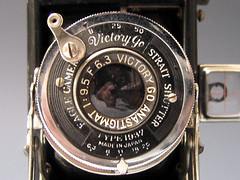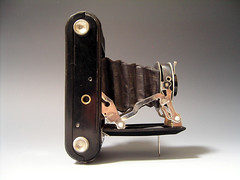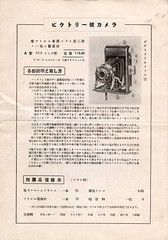Difference between revisions of "Victory"
Rebollo fr (talk | contribs) (1940 prices) |
Hanskerensky (talk | contribs) (Added Category:Japanese 127 film) |
||
| (37 intermediate revisions by 5 users not shown) | |||
| Line 1: | Line 1: | ||
{{Japanese Vest | {{Japanese Vest | ||
| − | |image=[http://www.flickr.com/photos/ | + | |image=[http://www.flickr.com/photos/camerawiki/48248826512/in/pool-camerawiki/ https://live.staticflickr.com/65535/48248826512_a4c0b18f9d_m_d.jpg]<br />''Picture by {{image author|Nakagi Tsuguhide}}. {{with permission}}'' |
}} | }} | ||
| − | The '''Victory''' (ビクトリー) is a Japanese folding camera taking both | + | The '''Victory''' (ビクトリー) is a Japanese folding camera taking both 4×6.5 and 3×4 pictures on [[127 film]]. |
== Description of the Victory A == | == Description of the Victory A == | ||
| − | + | The '''Victory A''' (ビクトリーカメラA型) is known from a leaflet published around 1937 and from pictures of some surviving examples.<REF> Leaflet: undated leaflet for the Victory, [[Semi Dymos]], [[Reex]], [[Japanese 3×4 and 4×4 pseudo TLR|Baby Ref]], [[Union Ref and Hansa Rollette Ref|Union Ref]] and [[Baby Chrome]]. Surviving examples: example formerly pictured on a page on AEI Collectibles, and examples observed in online auctions. </REF> In the leaflet, it is called "Victory Gō Camera" (ビクトリー號カメラ) on one place, with the Japanese character 號 meaning "number" or "type". | |
| − | |||
| − | |||
| − | |||
| − | The | ||
| − | + | The camera has a [[bakelite]] body. The folding struts have a complicated arrangement, copied from [[Kodak]] designs such as the Pocket Kodak Junior. | |
| − | + | There is a folding optical finder in the middle of the top plate and no body release. The advance knob is at the right end and there is a spool holder at the left end. The latter can be pulled out only after it is turned counter-clockwise. The back is hinged to the left and the text says that it contains three red windows, the middle one being used for 4×6.5 exposures and the other ones for 3×4. | |
| − | The | + | {| class="floatleft plainlinks" width=200px style="text-align: center;" |
| + | |- | ||
| + | || [http://www.flickr.com/photos/camerawiki/48249265426/in/pool-camerawiki/ https://live.staticflickr.com/65535/48249265426_b8a5343a67_m_d.jpg] | ||
| + | |- | ||
| + | || ''Lens and shutter. Picture by {{image author|Nakagi Tsuguhide}}. {{with permission}}'' | ||
| + | |} | ||
| + | The shutter is everset and gives B, 25, 50 speeds. The release lever is attached to the front of the shutter housing. The model name ''Victory Go'' is engraved at the top of the shutter plate. ("Go" is probably the Japanese character 號 told above.) The marking on the right reads ''STRAIT SHUTTER'', probably the shutter name; on the left there is the brand name ''EAGLE CAMERA''. The model year is indicated at the bottom, and the words ''<small>MADE IN JAPAN</small>'' are engraved below. The leaflet reads ''TYPE 1935'' or perhaps ''1936'', some surviving examples have ''TYPE 1936'' and one has ''TYPE 1937''. Despite the different model years, no other change is visible. | ||
| − | The | + | The lens is fixed-focus and the rim is engraved ''VICTORY GO ANASTIGMAT 1:9.5 F 6.3''. On most lenses, "1:9.5" would indicate the maximum aperture and the focal length would be written "F=6.3" with an indication of a unit, for example centimetres. In the case of the Victory Go, ''F 6.3'' stands for the maximum aperture, as indicated by the aperture scale going from 6.3 to 25, and the meaning of ''1:9.5'' is unclear. |
| + | {{br}} | ||
| + | {| class="plainlinks" align="center" style="text-align: center;" | ||
| + | |- | ||
| + | || [http://www.flickr.com/photos/camerawiki/48248826512/in/pool-camerawiki/ https://live.staticflickr.com/65535/48248826512_a4c0b18f9d_m_d.jpg] [http://www.flickr.com/photos/camerawiki/48249287851/in/pool-camerawiki/ https://live.staticflickr.com/65535/48249287851_03493511ca_m_d.jpg] [http://www.flickr.com/photos/camerawiki/48249381022/in/pool-camerawiki/ https://live.staticflickr.com/65535/48249381022_5268c338a2_m_d.jpg] | ||
| + | |- | ||
| + | || [http://www.flickr.com/photos/camerawiki/48250569186/in/pool-camerawiki/ https://live.staticflickr.com/65535/48250569186_08577cfca9_t_d.jpg] [http://www.flickr.com/photos/camerawiki/48250663487/in/pool-camerawiki/ https://live.staticflickr.com/65535/48250663487_98c418ed15_t_d.jpg] [http://www.flickr.com/photos/camerawiki/48250604466/in/pool-camerawiki/ https://live.staticflickr.com/65535/48250604466_4804ff7298_t_d.jpg] [http://www.flickr.com/photos/camerawiki/48250694647/in/pool-camerawiki/ https://live.staticflickr.com/65535/48250694647_705897e1ba_t_d.jpg] [http://www.flickr.com/photos/camerawiki/48254782066/in/pool-camerawiki/ https://live.staticflickr.com/65535/48254782066_9b3c250c6c_t_d.jpg] [http://www.flickr.com/photos/camerawiki/48254792291/in/pool-camerawiki/ https://live.staticflickr.com/65535/48254792291_976a83ca44_t_d.jpg] [http://www.flickr.com/photos/camerawiki/48254874592/in/pool-camerawiki/ https://live.staticflickr.com/65535/48254874592_85ae6711a6_t_d.jpg] | ||
| + | |- | ||
| + | || ''Victory A, type 1937. Pictures by {{image author|Nakagi Tsuguhide}}. {{with permission}}'' | ||
| + | |} | ||
| − | + | == Advertisements and other documents == | |
| + | {| class="floatleft plainlinks" width=200px style="text-align: center;" | ||
| + | |- | ||
| + | || [http://www.flickr.com/photos/camerawiki/48254887022/in/pool-camerawiki/ https://live.staticflickr.com/65535/48254887022_669b74300d_m_d.jpg] | ||
| + | |- | ||
| + | || ''Victory leaflet. {{flickr translated}} {{public domain Japan old}}'' | ||
| + | |} | ||
| + | In the leaflet cited above, the Victory A was offered for ¥18 including the portrait attachment. The text says that the "large aperture" of the lens equipping the Victory A only makes pictures possible from the infinity down to 10 feet, and that the attachment is needed to take closer pictures, down to 5 feet. | ||
| + | |||
| + | The official price list compiled in October 1940 and published in January 1941 also has a camera called "Victory", listed for ¥23 with no further detail.<REF> {{Kakaku0141_short}}, type 2, section 2. </REF> There is no indication of the company which made or sold the camera. | ||
== Other versions == | == Other versions == | ||
| − | {{ | + | {{SUG}} does not show the Victory A but two other models.<REF> {{SUG}}, items 4103–4. </REF> None of them has folding struts, and the lens standard is manually pulled out on two rails after opening the folding bed. The folding finder is different too, with the rear part folding over the front one. |
| − | |||
| − | |||
| − | + | In both cases, the shutter plate is marked ''Victory'' at the top and has a logo at the bottom, perhaps the letter "Y" inside a circle. The only speed settings are 25 and B. | |
| + | The lens is fixed-focus and the aperture scale goes from 8 to 32 on both cameras. One camera<REF> {{SUG}}, item 4103. </REF> has no lens engraving and certainly a single-element lens. The other<REF> {{SUG}}, item 4104. </REF> has a lens engraving similar to the Victory A, with ''VICTORY GO ANASTIGMAT'' and perhaps ''1:5.5 F 8''. The meaning of ''5.5'' is again unclear. This example has the top of the advance knob finished in black. | ||
| + | {{br}} | ||
== Notes == | == Notes == | ||
<references /> | <references /> | ||
== Bibliography == | == Bibliography == | ||
| − | + | === Original documents === | |
| − | * Leaflet for the Victory, [[Semi Dymos]], [[Reex]], [[Japanese | + | * Anonymous company. Leaflet for the Victory, [[Semi Dymos]], [[Reex]], [[Japanese 3×4 and 4×4 pseudo TLR|Baby Ref]], [[Union Ref and Hansa Rollette Ref|Union Ref]] and [[Baby Chrome]]. Date not indicated. Document reproduced in [https://www.flickr.com/photos/camerawiki/albums/72157712042809812/ this Flickr album] by Rebollo_fr. |
| − | * {{Zukan}} Items | + | * {{Kakaku0141}} Type 2, section 2. |
| + | |||
| + | === Recent sources === | ||
| + | * {{Zukan}} Items 4103–4. | ||
The Victory is not listed in {{Kokusan}}. | The Victory is not listed in {{Kokusan}}. | ||
| + | |||
[[Category: Japanese 4x6.5 viewfinder folding]] | [[Category: Japanese 4x6.5 viewfinder folding]] | ||
| + | [[Category:Japanese 127 film]] | ||
[[Category: Bakelite]] | [[Category: Bakelite]] | ||
[[Category: V]] | [[Category: V]] | ||
| + | [[Category: 1937]] | ||
Latest revision as of 05:34, 19 January 2024
The Victory (ビクトリー) is a Japanese folding camera taking both 4×6.5 and 3×4 pictures on 127 film.
Contents
Description of the Victory A
The Victory A (ビクトリーカメラA型) is known from a leaflet published around 1937 and from pictures of some surviving examples.[1] In the leaflet, it is called "Victory Gō Camera" (ビクトリー號カメラ) on one place, with the Japanese character 號 meaning "number" or "type".
The camera has a bakelite body. The folding struts have a complicated arrangement, copied from Kodak designs such as the Pocket Kodak Junior.
There is a folding optical finder in the middle of the top plate and no body release. The advance knob is at the right end and there is a spool holder at the left end. The latter can be pulled out only after it is turned counter-clockwise. The back is hinged to the left and the text says that it contains three red windows, the middle one being used for 4×6.5 exposures and the other ones for 3×4.

|
| Lens and shutter. Picture by Nakagi Tsuguhide. (Image rights) |
The shutter is everset and gives B, 25, 50 speeds. The release lever is attached to the front of the shutter housing. The model name Victory Go is engraved at the top of the shutter plate. ("Go" is probably the Japanese character 號 told above.) The marking on the right reads STRAIT SHUTTER, probably the shutter name; on the left there is the brand name EAGLE CAMERA. The model year is indicated at the bottom, and the words MADE IN JAPAN are engraved below. The leaflet reads TYPE 1935 or perhaps 1936, some surviving examples have TYPE 1936 and one has TYPE 1937. Despite the different model years, no other change is visible.
The lens is fixed-focus and the rim is engraved VICTORY GO ANASTIGMAT 1:9.5 F 6.3. On most lenses, "1:9.5" would indicate the maximum aperture and the focal length would be written "F=6.3" with an indication of a unit, for example centimetres. In the case of the Victory Go, F 6.3 stands for the maximum aperture, as indicated by the aperture scale going from 6.3 to 25, and the meaning of 1:9.5 is unclear.
  
|
      
|
| Victory A, type 1937. Pictures by Nakagi Tsuguhide. (Image rights) |
Advertisements and other documents

|
| Victory leaflet. Click on the image for a translation. (Image rights) |
In the leaflet cited above, the Victory A was offered for ¥18 including the portrait attachment. The text says that the "large aperture" of the lens equipping the Victory A only makes pictures possible from the infinity down to 10 feet, and that the attachment is needed to take closer pictures, down to 5 feet.
The official price list compiled in October 1940 and published in January 1941 also has a camera called "Victory", listed for ¥23 with no further detail.[2] There is no indication of the company which made or sold the camera.
Other versions
Sugiyama does not show the Victory A but two other models.[3] None of them has folding struts, and the lens standard is manually pulled out on two rails after opening the folding bed. The folding finder is different too, with the rear part folding over the front one.
In both cases, the shutter plate is marked Victory at the top and has a logo at the bottom, perhaps the letter "Y" inside a circle. The only speed settings are 25 and B.
The lens is fixed-focus and the aperture scale goes from 8 to 32 on both cameras. One camera[4] has no lens engraving and certainly a single-element lens. The other[5] has a lens engraving similar to the Victory A, with VICTORY GO ANASTIGMAT and perhaps 1:5.5 F 8. The meaning of 5.5 is again unclear. This example has the top of the advance knob finished in black.
Notes
- ↑ Leaflet: undated leaflet for the Victory, Semi Dymos, Reex, Baby Ref, Union Ref and Baby Chrome. Surviving examples: example formerly pictured on a page on AEI Collectibles, and examples observed in online auctions.
- ↑ "Kokusan shashinki no kōtei kakaku", type 2, section 2.
- ↑ Sugiyama, items 4103–4.
- ↑ Sugiyama, item 4103.
- ↑ Sugiyama, item 4104.
Bibliography
Original documents
- Anonymous company. Leaflet for the Victory, Semi Dymos, Reex, Baby Ref, Union Ref and Baby Chrome. Date not indicated. Document reproduced in this Flickr album by Rebollo_fr.
- "Kokusan shashinki no kōtei kakaku" (国産写真機の公定価格, Set prices of the Japanese cameras), listing Japanese camera production as of October 25, 1940 and setting the retail prices from December 10, 1940. Published in Asahi Camera January 1941 and reproduced in Shōwa 10—40nen kōkoku ni miru kokusan kamera no rekishi (昭和10〜40年広告にみる国産カメラの歴史, Japanese camera history as seen in advertisements, 1935—1965). Tokyo: Asahi Shinbunsha, 1994. ISBN 4-02-330312-7. Pp.108—9. Type 2, section 2.
Recent sources
- Sugiyama, Kōichi (杉山浩一); Naoi, Hiroaki (直井浩明); Bullock, John R. The Collector's Guide to Japanese Cameras. 国産カメラ図鑑 (Kokusan kamera zukan). Tokyo: Asahi Sonorama, 1985. ISBN 4-257-03187-5. Items 4103–4.
The Victory is not listed in Kokusan kamera no rekishi.